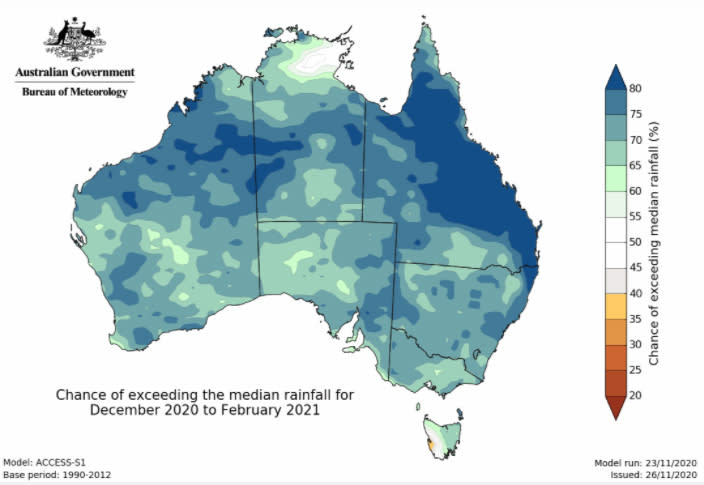Get set for a soaking: Concerning warning on widespread flooding issued for Australia
Australia is likely to avoid the carnage of another horror bushfire season, although a high risk of widespread flooding means it's not out of the woods.
In a welcome relief following Black Summer, the Bureau of Meteorology's climate outlook indicates a lower risk of bushfires over the 2020/21 season.
Instead, the bureau is warning of a wetter than normal summer, with an above-average chance of rainfall as a La Nina weather pattern likely peaks in December or January.
"There is a risk of widespread flooding, particularly in eastern Australia," BoM head of climate predictions Andrew Watkins told reporters on Thursday.
"There is a risk of widespread flooding in Queensland, NSW and Victoria but there is some elevated risk in other states as well."
Senior meteorologist Dean Narramore said it could be the first widespread summer flooding Victoria has had in almost a decade.
"For the last few years, we've had some really hot and dry summers interspersed with the odd day of a heavy rainfall event," he said.
"We remember in 2010 and 2011 (that) was probably the last really wet summer across much of Victoria."
What's the #BOMoutlook for #summer? #LaNina is active, suggesting above-average rain for much of Australia, increasing chances of widespread #flooding in the east.
Max. temps are likely to be warmer than average for SE parts, coastal Qld & far west WA https://t.co/jOG5BmAzwY pic.twitter.com/VenVtJ2VJH— Bureau of Meteorology, Australia (@BOM_au) November 26, 2020
With La Nina expected to remain in force until at least the start of autumn, Australia's north is in for an above-average cyclone season.
Australia usually has nine to 11 tropical cyclones each year, with four or so crossing the coast.
"This season we are expecting around about a 67 per cent chance of an above-average number of tropical cyclones in Queensland," Dr Watkins said.
"Typically they see four cyclones a season and one will cross the coast.
"We're expecting at least that this season."
Dr Watkins urged people to immediately start readying themselves and their homes for the cyclone season.
While the risk of bushfires isn't as high as 12 months ago, blazes will still flare up with warm weather and rain accelerating plant growth and increasing fuel levels.
The bushfire outlook shows grass fires are predicted in large parts of southeast Australia, including Victoria's northeast and the Blue Mountains in NSW.
"In NSW and Victoria, grass fires are very much the greater concern rather than bushfires this year," researcher John Bates said.
Dr Bates nominated WA, particularly in the south and southwest, as the most likely state to be hit by bushfires due to a lack of rain in the region.

"They were already dry and that dryness has continued," he said.
There will be fires in SA too, but Dr Bates said it wouldn't be an unusual season.
Despite the lessening risk of bushfires, Australia is tipped to once again sweat through multiple heatwaves this summer.
Although temperatures are unlikely to reach the extremes seen in previous years, Dr Watkins said the heatwaves could last longer and feature increased humidity.
"We could have some more of those muggy days and those uncomfortable nights," he said.
Much of southeast Australia is set for taste of heatwave conditions before summer even hits, with temperatures 8-12C hotter than usual from Kalgoorlie to Canberra on Thursday.
"This heat will intensify further as we move into Friday, particularly in SA where temperatures will reach 15 to 18 degrees above average," Mr Narramore said.
"That heat will really peak through inland SA and western parts of NSW on Saturday, with temperatures approaching the mid to high 40s through inland areas (and) will also creep into northern parts of Victoria."
Do you have a story tip? Email: newsroomau@yahoonews.com.
You can also follow us on Facebook, Instagram and Twitter and download the Yahoo News app from the App Store or Google Play.



